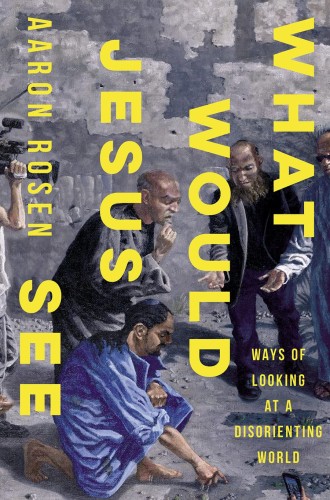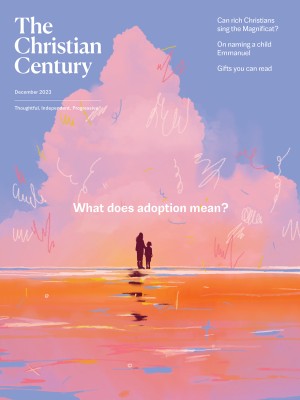The artistic vision of Jesus
Aaron Rosen finds that Jesus looks at the world the way artists see their subjects.
“Performance art” is the term Aaron Rosen uses in his new book to describe moments in Jesus’ ministry, and it quickly becomes apparent that this use of the term is not at all irreverent. What Would Jesus See is a remarkable and enlarging exploration of Jesus’ view of the world and his unrelenting attempts to help us see the same way. Rosen (a CENTURY columnist) believes that when necessary, Jesus uses “intentionally theatrical” words and actions to call our attention to the importance of how we see.
For example, when in John’s Gospel Jesus is called to arbitrate the fate of the woman taken in adultery (7:53–8:11), he famously pauses and writes in the sand. What he writes we do not know, but that is the point, Rosen says: to simply create a spectacle, a diversion to suspend the injustice that’s playing out. With this visual detour, Jesus leads her accusers from “certitude to confusion,” and the “scornful gaze” of the crowd is reflected back at them. Likewise, the mud and spittle Jesus places on the eyes of the blind man a few chapters later (John 9:1–12) is a ritual used for dramatic effect. Jesus could have healed the man with a word. But as the man washes his eyes and receives his sight, the sequence of events effectively dramatizes for the onlookers what constitutes true blindness and true vision.
Read our latest issue or browse back issues.
Tackling a question as large as “What would Jesus see?” gives Rosen room to dive into the many surprising dimensions of sight that play out in the gospels, with relevance for the challenges of today’s political and social environment. “Eagle-eyed, unpredictable, and brilliant,” Jesus models how transformative right seeing can be. He sees others with empathy and heals them; he sees through the false piety of certain religious leaders and exposes them; he even teaches about how to “see” into the future, a matter of great interest not only in his day but also today, as climate change is upon us. Jesus’ stern teaching about the direct connection between the lust of the eye and adultery in the Sermon on the Mount spells out how vision and action are inextricably bound together. Rosen sums up: “For Jesus, seeing was doing.”
Rosen is the right person to bring us this fresh lens on the gospels. A Jewish scholar of religion and an art curator, he has written widely on art and religion. As the spouse of an Episcopal priest, he is also a close observer of the practical lives of Christian disciples. With a panoply of artists in his repertoire, from classical to contemporary, Rosen offers a range of visual art that highlights the way artists see their subject. This perceptiveness, Rosen shows, is similar to the way Jesus pays attention to his surroundings, both the injustices and the things worth commending. Like an artist, Jesus makes us “question what we think we see.” Rosen makes a convincing case that disciplined vision is an indispensable faculty of the spiritual life, not only for Christians but for anyone who wishes to be a healer in this world.
With the church in mind, I found the chapter titled “Recognizing Others” particularly helpful for working toward unity and inclusiveness with marginalized people. Borrowing from Martin Buber, Rosen suggests that the temptation to see people as “other,” as an object, persists. The work now is to “repair and retrain our sense of recognition” and remember that Jesus looks at others “with a love that does not objectify or transfix” and permits the one he truly sees to “become themselves in his presence. . . . Jesus seems uniquely capable of recognition without preconception.” The reference to Buber is just one of Rosen’s many nods to leading lights of literature, philosophy, science, theology, and more. Cultivating a spiritual view of the world, it seems, is of universal value.
Rosen is at his best when he delves extensively into the form of seeing known as discernment. What does it take to discern the truth, and in particular, divine truth? Rosen describes a deliberate process—a sustained effort entailing humility, patience, and study. It is refreshing to hear that such a discipline will eventually yield its fruit, even amid our current “moral and civic decline” in which “confusion between fact and opinion leads to a disorienting landscape in which truth is not only obscured but irrelevant.”
When it comes to discerning the identity of Jesus, who often avoids self-disclosure, Rosen connects us with the holiness that is integral to the truth we endeavor to uncover. He posits that “Jesus’s assertion that most people can’t handle or even recognize the truth might sound inequitable on the surface, but it safeguards the radical alterity, or otherness, of divine truth.” Turning to the way Jesus’ disciples only gradually recognize him in his risen state, Rosen says that there are deep purposes here as well, one of which is to demonstrate that in this case, “sensory perception alone” is not enough. The challenge of learning truth, it seems, involves a healthy respect for the forces that keep it hidden.
With a book so thorough and so grounded in scripture, I was surprised that Rosen didn’t include a discussion of the biblical word behold, the urgent imperative to pay attention that is spoken by God’s messengers whenever a sacred, significant moment is unfolding. Yet perhaps beholding is the very idea which Rosen carries forward in this timely work. What Would Jesus See is a revelatory and eloquent exposition about the necessity of paying attention to what God would have us see as a prerequisite to doing what God would have us do. Rosen persuades us that such attentiveness is not just an opportunity but a responsibility with a clear path forward, even today. Jesus, he explains, “invites us to look closely with him, to extend his insights into ever-new periods and contexts.”






